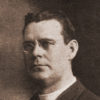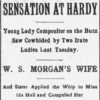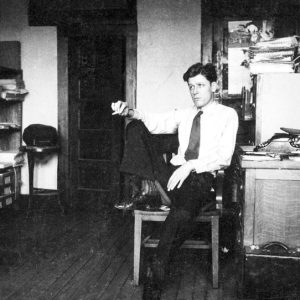calsfoundation@cals.org
Socialist Party
Partly as a result of the extreme poverty that has plagued the state and partly due to the fiercely independent nature of the people in the more mountainous regions of Arkansas, there has long existed a portion of the populace that frequently supported political movements outside the long-dominant Democratic Party. While such movements failed to overthrow the Democrats, they served the discontented elements in the state and gave them a platform of their own. Among the strongest of the third-party groups was the Socialist Party.
Arkansas, along with Louisiana, Texas, and Oklahoma, possessed some of the strongest statewide groups in the nation prior to World War I. The earliest formal effort to create a state group occurred in 1898, but that group was short lived. A second wave formed a few years later centered in Little Rock (Pulaski County). In November 1902, the Arkansas Gazette reported that the party had as many as 500 members in the city, with many coming from outside the working class.
There was also a strong contingent of socialists forming on the western border of the state in the Fort Smith (Sebastian County) area, affiliated with the United Mine Workers (UMW) locals in the mining towns. The center of western socialism was Huntington (Sebastian County), where a local lawyer named Dan Hogan established a Socialist Party newspaper, The Southern Worker. Hogan found kindred spirits among his neighbors, including Ernest W. M. Perrin, George Mikel, Uncle Pat O’Neill, and Father Thomas Haggerty, all of whom played important roles in the party during its early years. Mikel was in a high leadership position with the state American Federation of Labor (AFL) group. The AFL provided broad support for the party, with a column dedicated to the Arkansas party in its national newspaper.
The first state party convention took place in Little Rock in 1903. Its platform called for free and compulsory education, equal rights for women, national health insurance, and pension programs, among other ideas. By the end of the year, there were twenty-eight groups (called locals), mostly in the Little Rock area and the western part of the state. William O. Penrose, a Woodruff County lumberman and sawmill owner, was nominated to be the party’s candidate for governor. He came in fourth after the Democrats, Republicans, and Prohibitionists, but the party faithful were energized by his showing.
By 1906, dissatisfaction with the AFL among party leaders in the state resulted in a split. Men like Haggerty and Pat O’Neill joined the Industrial Workers of the World (IWW), commonly called the “Wobblies,” a more radical union group, and the Socialist Party in Arkansas lost its national support from the AFL, including the regular newspaper column. This resulted in a move away from the miners and toward the farmers in the state. Strong gains in membership began to be seen in the eastern part of the state. The Independence County group offered up a full slate of candidates in every election from 1906 until 1920. A popular secretary from Combs (Madison County) named J. S. Faubus achieved some power in the statewide organization. His son, Orval Eugene Faubus (the middle name coming from national party leader Eugene V. Debs), later became governor of Arkansas.
The Socialist Party in the state ran candidates for governor for each election from 1908 to 1918, including the Sebastian County lawyer Hogan, who ran in 1906, 1910, and 1914, while his daughter, Freda Hogan, worked with socialist women in advocating for women’s suffrage; she became secretary to the state party in 1914. The year 1912, when gubernatorial candidate G. E. Mikel received 13,384 of the votes cast in the general election (out of 169,649 total), was to be the high point for the Socialist Party in Arkansas, as disputes between labor factions thereafter sapped the strength of the party. The party virtually died in the state during World War I, in part as a consequence of socialist opposition to American involvement in the war and the official repression resulting from that stand. Clay Fulks, who served as a delegate to the 1917 Socialist Party’s national convention opposing the war, ran as a candidate for governor in 1918 but only secured 4,792 out of 72,984 total votes against an otherwise unopposed Charles Brough.
Socialism sparked again in the Arkansas Delta in the 1930s behind the leadership of two young businessmen from Tyronza (Poinsett County)—H. L. Mitchell and Clay East—who were leaders in the second wave of socialism to hit the state. In February 1934, they hosted Socialist Party leader Norman Thomas at Tyronza. After visiting with several area farmers and addressing a large group at the local school, Thomas suggested that the two form a union of sharecroppers and tenant farmers to combat issues that arose from New Deal programs during the Great Depression, and that group, the Southern Tenant Farmers’ Union, in many ways replaced the political party. A socialist candidate, J. Russell Butler, appeared on the ballot in 1936, but he received only 733 votes out of a total 184,460.
Like the national party, the Arkansas Socialist Party suffered with the advent of World War II, and the Cold War that followed again brought an end to any serious ideas of socialist leadership in the state. However, Pine Bluff (Jefferson County) native Mary Cal Hollis of the Socialist Party USA was a candidate for U.S. president in 1996 and a candidate for vice president in 2000.
For additional information:
Clay Fulks Papers. Special Collections. University of Arkansas Libraries, Fayetteville, Arkansas.
Dunbar, Anthony. Against the Grain: Southern Radicals and Prophets, 1929–1959. Charlottesville: University of Virginia Press, 1981.
Gay, James Thomas. “Norman Thomas: Tribune of the Disenfranchised.” Arkansas Historical Quarterly 48 (Winter 1989): 329–348.
Green, James. R. Grass-Roots Socialism: Radical Movements in the Southwest, 1895–1943. Baton Rouge: Louisiana State University Press, 1978.
Grisham, Cindy L. “When Hope Grows Weary: An Arkansas Delta Town in Space and Place.” PhD diss., Arkansas State University, 2012.
Kiser, G. Gregory. “The Socialist Party in Arkansas, 1900–1912.” Arkansas Historical Quarterly 40 (Summer 1981): 119–153.
Manthorne, Jason. “The View from the Cotton: Reconsidering the Southern Tenant Farmers Union.” Agricultural History 84 (January 2010): 20–45.
Martin, Robert F. Howard Kester and the Struggle for Social Justice in the South, 1904–77. Charlottesville: University of Virginia Press, 1991.
Mitchell, H. L. Mean Things Happening in this Land: The Life and Times of H. L. Mitchell, Co-Founder of the Southern Tenant Farmers Union. Norman: University of Oklahoma Press, 2008.
Pierce, Michael. “Great Women All, Serving a Glorious Cause: Freda Hogan Ameringer’s Reminiscences of Socialism in Arkansas.” Arkansas Historical Quarterly 69 (Winter 2010): 293–324.
Ross, James D., Jr. “‘I ain’t got no home in this world’: The Rise and Fall of the Southern Tenant Farmers’ Union in Arkansas.” PhD diss., Auburn University, 2004.
Socialist Party Documents. Special Collections. University of Arkansas Libraries, Fayetteville, Arkansas.
Ventkateramani, M. S. “Norman Thomas, Arkansas Sharecroppers, and the Roosevelt Agricultural Policies, 1933–1937.” Arkansas Historical Quarterly 24 (Spring 1965): 3–28.
Whitaker, Robert. On the Laps of Gods: The Red Summer of 1919 and the Struggle for Justice that Remade a Nation. New York: Crown Publishers, 2008.
William A. Gilbert Papers. Special Collections. University of Arkansas Libraries, Fayetteville, Arkansas.
Youngblood, Joshua C. “Realistic Religion and Radical Prophets: The STFU, the Social Gospel, and the American Left in the 1930’s.” MA thesis, Florida State University, 2004.
Cindy Grisham
Benton, Arkansas
 Callery, Ida Hayman
Callery, Ida Hayman Commonwealth College
Commonwealth College Communist Party
Communist Party Early Twentieth Century, 1901 through 1940
Early Twentieth Century, 1901 through 1940 Hagerty, Thomas J.
Hagerty, Thomas J. Morgan, Winfield Scott
Morgan, Winfield Scott Red Scare (1919–1920)
Red Scare (1919–1920) Harry Mitchell
Harry Mitchell 




Comments
No comments on this entry yet.